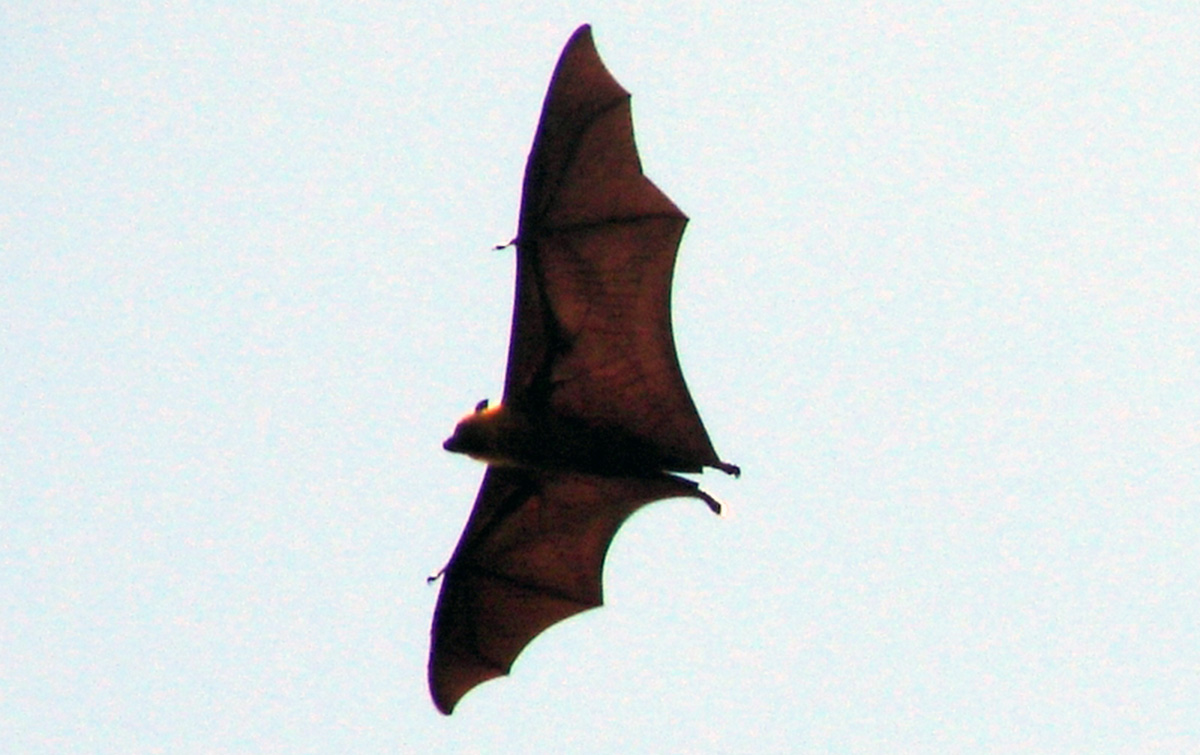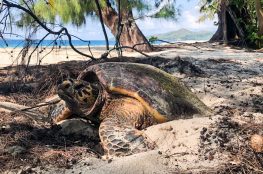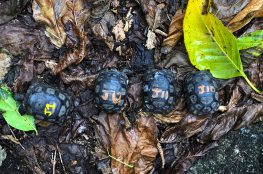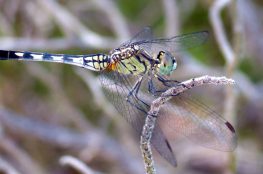Fruit bats or Flying Foxes in Seychelles (Pteropus seychellensis) are often seen skimming over the sea and this behaviour has given rise to much speculation. However, there are a lot of field observations and publications over the last 100 years of fruit bats of the genus Pteropus skimming over freshwater bodies such as rivers, lakes, reservoirs and even swimming pools. Close observations show that the bats dip their chests in the water as they fly over and then lick the water off when they roost. They can also dip their feet and then lick at these afterwards (Bergmans, 1978).
Many Pteropus species are found in coastal areas and islands and have been seen drinking salt water (Kingdon, 1974; Kock, 1972; Nelson, 1989; Ratcliffe,1961). It has been said that this is to supplement certain minerals lacking in their diet (Fenton, 2001; Kretschnann and Hayes, 2004). Animals in general actively seek salt as it appears to be a limiting factor for some especially in the tropics. As the fruits and leaves of food plants of fruit bats may be rich in water but poor in salt (Herrera, 1987; O’Brien et al, 1998) it has been assumed that they need to drink seawater. Their kidneys appear adapted to excreting salt (Iudica et al, 1994).
Certainly fruit bats in captivity are given salt solutions in addition to freshwater on the basis of these observations. When Pteropus poliocephalus and P.alecto were given a choice between freshwater and saltwater (at half the concentration of sea water), the bats drank 2 to 8 times more saltwater than freshwater (Nelson, 1989). However, when the salt solution equaled or exceeded the salt concentration of sea water, the bats drank up to 9 times as much freshwater (Barnard 2011).
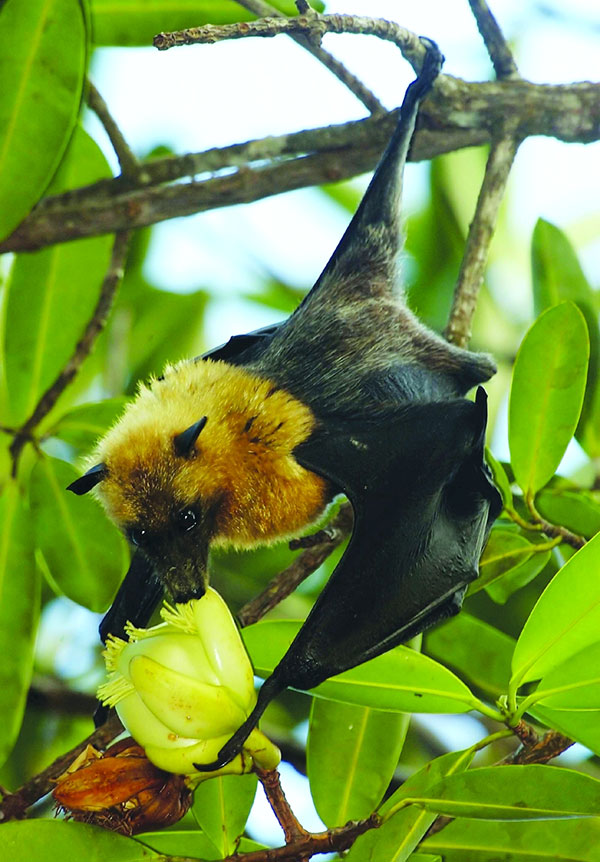
Seychelles fruit bat (Photo: Nature Seychelles) 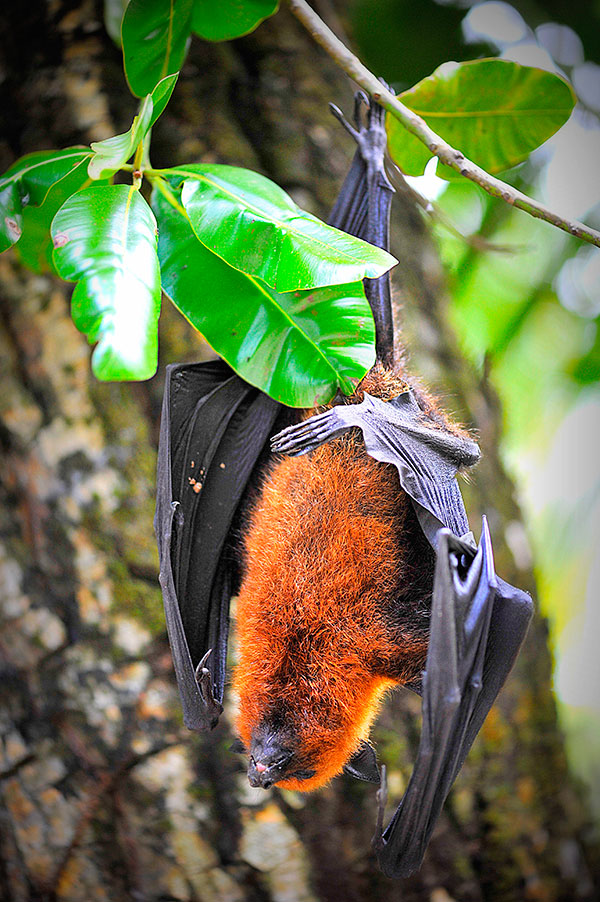
Seychelles fruit bat (Photo: Dave Rodgers)
Like adults in care, fruit bat pups also usually prefer salt water to fresh (Tolga Bat Hospital). At the Tolga Bat Hospital in Australia 1 teaspoon of sea salt (ground up) is mixed with 1 litre of water.
Do the bats drink directly from the sea or do they dip their breasts or chests to lick the salt later? Observations of 3 species of Pteropus in New Guinea showed that they dip their muzzles in the water (Iudica and Bonaccorso, 2003). An observer in Seychelles has noted that Pteropus seychellensis dips its breast (Gerlach, 2003). This observer attributes this behavior to bats trying to rid themselves of parasites.
Mr. R.C. Wood, a naturalist living on Cerf Island off the main island of Mahe in the 1950’s, observed some 60 to 100 fruit bats wetting their abdomen and feet (Wood, unpublished notes). The process has been dubbed “body-wetting” and has been observed in the Comorian sub-species (Pteropus seychellensis comorensis) although it is attributed to thermoregulatory functions (Stobbs 1994). It may be that the bats lick the salt off their abdomens and feet when at rest and out of sight of observers.
Pteropus vampyrus in the Philippines regularly body-dips in the ocean presumably to obtain sodium during later grooming (Stier 2003). This particular study suggests that the behaviour may be integral to the life of the species since the ocean dipping provides the bats with salts, and further, “that this is a critical resource that limits the distribution of some species” (ibid).
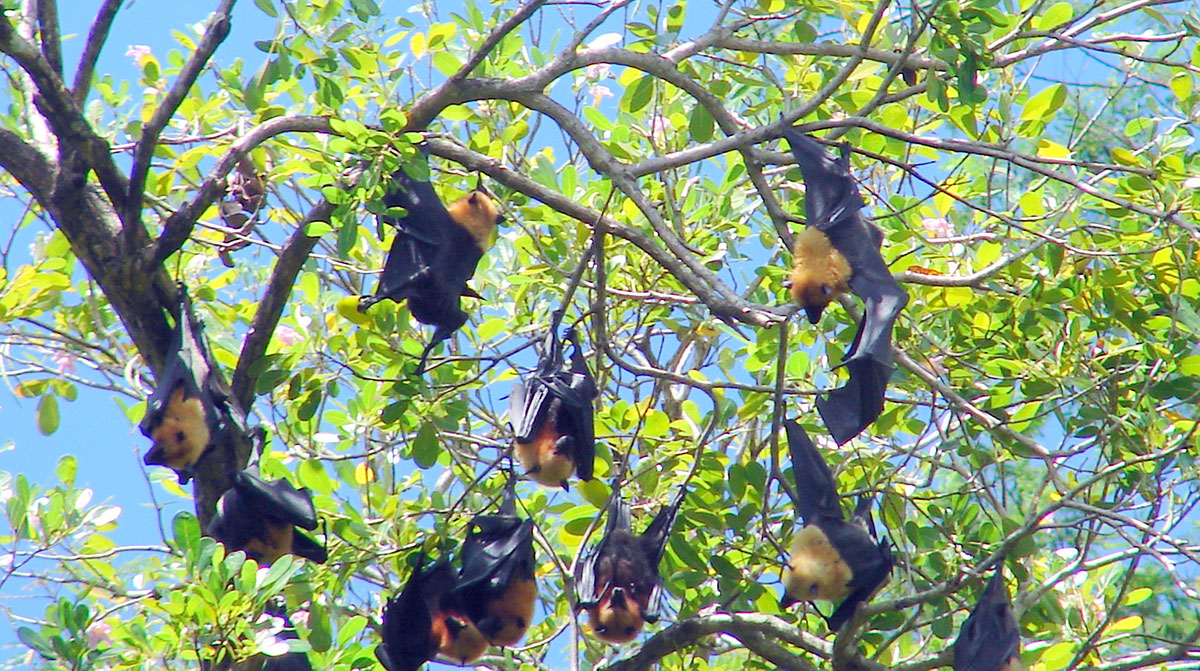
Seychelles Fruit Bat (Photo: Dao Nguyen)
Although skimming over the sea may be a risky strategy (Gerlach, 2003) “..flying foxes, often island inhabitants, may have to fly long distances to obtain food. A forced landing or a foray over water to collect fruit which has dropped and floated there may necessitate an unexpected swim. Photographs of the flying fox, Pteropus giganteus, show the animal actually swimming, using its wings and feet to reach land rather than floating or paddling.” (Encyclopedia Smithsonian, 1980). The Australian Spectacled Fruit Bat (Pteropus conspicillatus) risks being caught by saltwater crocodiles (Crocodylus porosus) whilst drinking seawater (Nelson, 1989).
To prove without doubt that fruit bats really need salt for their metabolic balance, one may need “…to demonstrate that species of Pteropus can produce a hypotonic urine while able to conserve salts when fed on a water-rich and salt-poor diets, and alternatively would also be capable of producing hypertonic urine when fed on a water-rich, salt-rich diet”. (Iudica and Bonaccorso, 2003)
By Dr Nirmal Shah is Nature Seychelles’ Chief Executive
Edited 11.4.2012
Edited 2019 to add a video of bat filmed swimming in a river in India.
Refs.:
Bergmans, W. 1978. Review of drinking behaviour of African fruit bats (Mammalia: Megachiroptera). Bull. Carnegie Mus. nat. Hist. 6: 20–25.
Barnard. S.M. 2011. Diet and Feeding (from Bats in Captivity). Small Mammal Mail – Bi-Annual Newsletter of CCINSA & RISCINSA. 3 (2): 17
Encyclopedia Smithsonian. 1980. Bat facts.
http://www.si.edu/Encyclopedia_SI/nmnh/batfacts.htm
Fenton, M. 2001. Bats. Checkmark Books, Revised Edition. New York, NY.
Gerlach, J. 2003. Sea-skimming by Seychelles fruit bats. Phelsuma. 11. 2003: 80.
Hall, L. 1983. Spectacled flying fox. In R. Strahan (ed.). The Mammals of Australia, Reed Books, Chatswood, 282.
Iudica, C.A and F.J. Bonaccorso 2003. Anecdotal observations of seawater ingestion by flying foxes of the genus Pteropus (Chiroptera: Pteropodidae). Mammalia. 67(3): 455-458.
Iudica, C.A, F.J. Bonaccorso, and G. Richard. 1994. Sea water ingestion in Pteropus hypomelanus. Bat Research News. 35(4):102 (Abstr.).
Kingdon, J. 1974. East African mammals. An atlas of evolution in Africa. II, A (insectivores and bats). Academic Press, London and New York.
Kock, D. 1972. Fruit-bats and bat-flowers. Bull. E. Afr. nat. Hist. Soc. 1972:123–126.
Kretschnann, K and R.L. Hayes. 2004. Old world fruit bats- Pteropus 1. http://www.Jiffynotes.com/a_study_guides/book_notes/grze_13/grze_13_00825.html
Nelson, J.E. 1989. Pteropodidae. In Walton, D.W. and B.J. Richardson (eds.). Fauna of Australia, Vol. 1B. Australian Government Publishing Service, Canberra, ACT, Australia. 852–856.
O’Brien, T.G, M.F. Kinnard, E.S. Dierenfeld, N.L. Conklin, R.W. Wrangham and S.C. Silver. 1998. What’s so special about figs? Nature. 292:668.
Ratcliffe, F.N. 1961. Flying foxes drinking sea water Journal of Mammalogy. 42: 252–252.
Stiers, S.C. 2003. Dietary habits of two threatened co-roosting Flying Foxes (Megachiroptera), Subic Bay, Philippines. Unpublished MSc Thesis. University of Montana, USA.
Stobbs, R.E.1994. Piscivory in the Comoro Islands flying fox Pteropus seychellensis comorensis – A refutation . South African Journal of Science. 90 (5): 264-265. http:/www.tolgabathospital.org/hospital_orphans.htm

